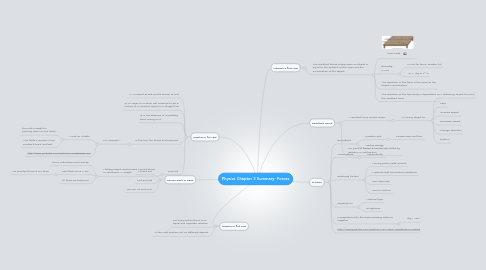
1. Forces work in pairs
1.1. 1st and 3rd
1.2. 2nd and 3rd
1.3. NEVER 1st and 2nd
2. Newton's 1st Law
2.1. 1) An object at rest would remain at rest
2.2. 2) An object in motion will continue to be in motion at a constant speed in a straight line
2.3. 3) In the absence of a resulting force acting on it
2.4. In this law, the forces are balanced
2.4.1. For example...
2.4.1.1. A rock on a table
2.4.1.1.1. The rock's weight is pushing down on the table
2.4.1.1.2. The table's reaction force pushes it back (3rd law)
2.4.1.2. http://www.youtube.com/watch?v=4NQbeZ0EXZQ
2.5. Free-fall
2.5.1. A falling object would reach a point where Air resistance = Weight
2.5.1.1. This is called terminal velocity
2.5.1.2. Resultant Force = 0N
2.5.1.2.1. No resultant force ≠ No force
2.5.1.3. All force are balanced
3. Newton's 3rd Law
3.1. For every action there is an equal and opposite reaction
3.2. Action and reaction act on different objects
4. Newton's 2nd Law
4.1. The resultant forces acting upon an object is equal to the product of the mass and the acceleration of the object.
4.1.1. New node
4.1.2. Basically, F=ma
4.1.2.1. SI unit for force: newton (N)
4.1.2.2. 1N = 1kg m s^-2
4.1.3. The direction of the force is the same as the object's acceleration
4.1.4. The direction of the free body is dependent on the resultant force
5. Resultant Force
5.1. A resultant force would cause...
5.1.1. A moving object to...
5.1.1.1. A stationary object to move
5.1.1.2. Stop
5.1.1.3. Increase speed
5.1.1.4. Decrease speed
5.1.1.5. Change direction
5.1.1.6. Deform
5.2. For parallel forces, it can be calculated by addition or subtraction
6. Friction
6.1. Bad effects
6.1.1. Creates Heat
6.1.1.1. Causes wear and tear
6.1.2. Wastes energy
6.2. Good effects
6.2.1. Prevents slip
6.3. Reducing friction
6.3.1. Moving parts made smooth
6.3.2. Materials with low friction resistance
6.3.3. Use lubricants
6.3.4. Use air cushion
6.4. Depends on
6.4.1. Material type
6.4.2. Roughness
6.5. is proportional to the force pressing surfaces together
6.5.1. 1kg = 10N
